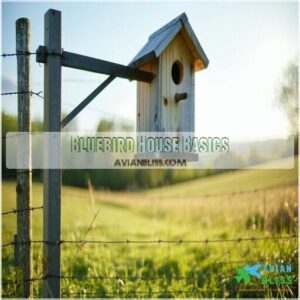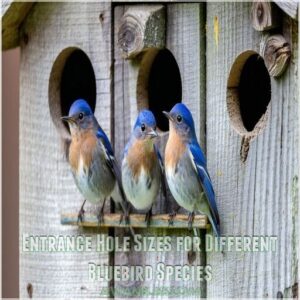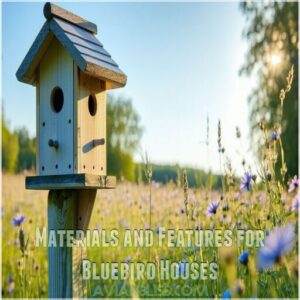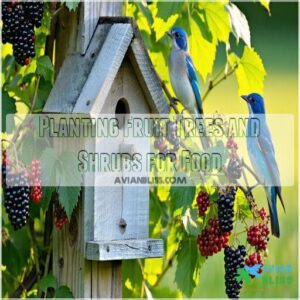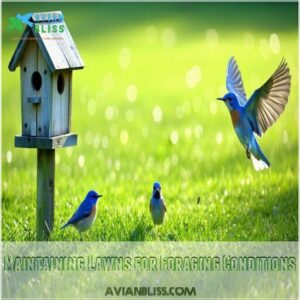This site is supported by our readers. We may earn a commission, at no cost to you, if you purchase through links.
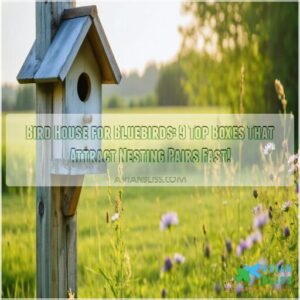 A proper bird house for bluebirds isn’t just a box—it’s a mini paradise for these colorful insect-eaters.
A proper bird house for bluebirds isn’t just a box—it’s a mini paradise for these colorful insect-eaters.
You’ll want a sturdy wood design, like cedar, with a 1.5-inch entrance hole (perfect for bluebirds but too small for pesky starlings).
Place it 4-6 feet high on a pole or post, far from busy feeders or dense brush, so predators can’t sneak up.
Add a predator guard for extra safety—nobody likes uninvited guests!
Keep the house facing open areas, because bluebirds are fans of roomy lawns and meadows.
Curious about the best designs or how to maintain them? Stay tuned for more tips!
Table Of Contents
- Key Takeaways
- Bluebird House Basics
- Top 9 Bluebird Houses
- 1. Enjoying Bluebirds More Bird Watchers
- 2. Cedar Bird House Copper Guard 2pk
- 3. Cedar Bluebird House Wild Wings Box
- 4. Cedar Bluebird House Nature’s Way
- 5. Blue Bird House with Predator Guard
- 6. Waterproof Wooden Bluebird House Outdoor
- 7. Dreyoo Cedar Bluebird House Two Pack
- 8. Wooden Bird House with Pole
- 9. Cedar Bluebird House Viewing Window
- Bluebird House Specifications
- Creating Bluebird Habitat
- Bluebird House Maintenance
- Frequently Asked Questions (FAQs)
- What kind of bird house do bluebirds like?
- Which way do you face a bluebird house?
- How big should a birdhouse be for a bluebird?
- How do you attract bluebirds to a bluebird house?
- Can Bluebirds live in a birdhouse?
- How big should a Bluebird house be?
- Which Bluebird house is best?
- What makes a house for bluebirds?
- What color bird houses attract bluebirds?
- How do bluebirds find birdhouses?
- Conclusion
Key Takeaways
- You’ll need a cedar or wooden bluebird house with a specific 1.5-inch entrance hole that welcomes bluebirds while keeping starlings and other predators out.
- Mount your bluebird house 4-6 feet high on a pole (not a tree) in an open, grassy area facing east, and add a predator guard to prevent raccoons, snakes, and other threats.
- Ensure your bluebird house has proper ventilation, drainage holes, and a sloped roof to keep nests dry and comfortable for nesting families.
- Maintain your bluebird house by regularly cleaning it between broods, monitoring for pests like blowflies, and creating a complete habitat with water sources and natural food like berry-producing shrubs.
Bluebird House Basics
You’ll need the right bluebird house with proper ventilation, drainage holes, and a 1.5-inch entrance hole to attract these colorful visitors to your yard.
The perfect bluebird house pairs ventilation, drainage, and a 1.5-inch entrance—your ticket to a vibrant, feathered show in your yard!
When you install your box on a metal pole with predator guards in an open, grassy area facing east, you’re setting the stage for front-row seats to nature’s most charming family drama, with proper ventilation being key to their comfort.
Ideal Locations for Bluebird Houses
Not sure where to put your bluebird house? Choose open spaces with minimal predator concerns. Aim for open habitat, like grassy fields or lawn edges—far from sheds or dense cover.
For happy bluebirds:
- Face entrances east or southeast to dodge harsh winds.
- Provide proximity to water for hydration.
- Pair placement matters: space boxes 300 feet apart for peaceful neighbors.
These birds thrive in specific open environments.
Mounting Bluebird Boxes for Success
Mounting your bluebird house properly guarantees success.
Use a sturdy pole mounting system, adding a baffle to block predators.
Place the nestbox at 5 feet for easy access and safety.
Site selection matters—choose open spaces, avoiding trees or dense cover.
Face the house east to shield from harsh winds.
A secure setup invites bluebirds, not troublemakers!
Consider a specialized mounting option for maximum stability.
Predator Guards and Notches for Bluebirds
Protecting bluebird houses is easier with good predator guards. Use baffles on mounting poles to block raccoons and snakes.
Choose copper or metal guard materials for long-lasting defense. A variety of options exist, including stovepipe and cage guards.
Avoid adding perches—they invite sparrows. Make certain the entrance hole size is 1.5 inches for bluebirds.
A well-placed birdhouse design keeps mounting heights around five feet for safety and sparrow deterrents reliable.
Top 9 Bluebird Houses
Finding the perfect bluebird house isn’t just about looks—it’s about creating a safe and inviting home for these charming birds.
You’ll love these top nine options that combine smart design with features to keep predators out and bluebird families happy.
1. Enjoying Bluebirds More Bird Watchers

Enjoying Bluebirds More" is a gem for bluebird enthusiasts, offering expert advice in just 32 pages.
This practical guide dives into bluebird nesting, housing, and habitat needs, making it perfect for beginners or seasoned bird lovers.
Vibrant photos and personal stories bring the information to life, while step-by-step instructions simplify creating bluebird-friendly spaces.
You’ll even find tips on troubleshooting common issues, from predators to maintenance, making it a compact and informative resource, like getting a bird whisperer in pamphlet form!
Best For: Beginners and experienced bird enthusiasts who want a compact guide to attract and care for bluebirds.
- Vibrant photos and illustrations make it visually engaging.
- Includes step-by-step tips for creating bluebird-friendly spaces.
- Covers troubleshooting and predator prevention effectively.
- Limited to 32 pages, so some topics may not be covered in depth.
- Availability issues since it’s currently backordered.
- Pamphlet format may not appeal to those preferring detailed manuals.
2. Cedar Bird House Copper Guard 2pk
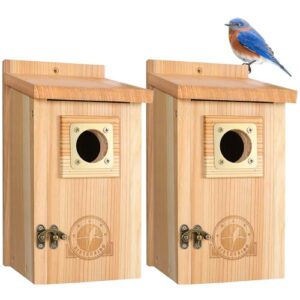
The Cedar Bird House Copper Guard 2pk offers a cozy refuge for bluebirds and their feathered friends.
Crafted from untreated cedar with a copper guard to keep out pesky predators, it’s like a country inn for birds.
The 1-1/2” entrance hole is a perfect fit for bluebirds, swallows, and chickadees, while the rough grooves inside help fledglings exit with ease.
Its weather-resistant design guarantees lasting comfort, and the easy-to-clean front door makes maintenance a breeze.
Bluebirds will feel right at home!
Best For: Bird enthusiasts looking to attract bluebirds, wrens, swallows, and chickadees while keeping predators out.
- Made from untreated cedar for a safe, natural bird habitat.
- Copper predator guard protects young birds from predators.
- Easy to clean and reuse for multiple seasons.
- Assembly required with a screwdriver.
- Not painted or treated, which may require additional care by users.
- May not accommodate larger bird species.
3. Cedar Bluebird House Wild Wings Box
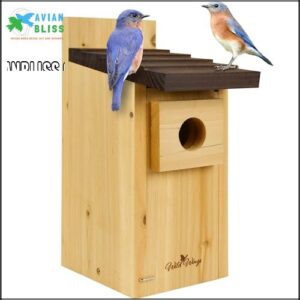
When you’re shopping for a reliable bluebird house, the Wild Wings Cedar Bluebird House is a no-brainer.
Made from rot-resistant cedar, it naturally keeps bugs at bay while providing safe shelter.
The clean-out door makes tidying up between broods a breeze, and the built-in predator guard offers essential protection for young birds.
With side vents for airflow, it creates a cool, comfy environment during warmer months.
Plus, the farmhouse design attracts bluebirds and also makes your yard look picture-perfect, providing a safe shelter.
Best For: Homeowners and bird enthusiasts looking to attract bluebirds while adding a functional and decorative element to their yard.
- Made from durable, rot-resistant cedar wood.
- Easy to clean with a convenient front-opening design.
- Includes a predator guard to keep young birds safe.
- Some customers reported shipping damage upon delivery.
- No predrilled mounting holes included.
- Requires additional modifications for certain bird species like Chickadees.
4. Cedar Bluebird House Nature’s Way

In the case of charming bluebirds, the Nature’s Way Cedar Bluebird House is like a VIP suite.
Made from rot-resistant cedar, it’s sturdy and weatherproof, guarding against the elements and predators alike.
The 1.5-inch entry hole is bluebird-friendly, with fledgling kerfs to help youngsters safely navigate out.
Its elevated mesh floor combats pesky blowfly infestations, while air vents guarantee a cozy, ventilated space.
Cleaning is simple with its side door.
This durable, well-designed house is perfect for any bluebird enthusiast!
Best For: Bluebird enthusiasts looking for a durable, predator-resistant birdhouse with easy maintenance and safety features.
- Made from rot-resistant cedar with rust-free hardware for durability.
- Features an elevated mesh floor and predator guard for bird safety.
- Side door allows convenient cleaning and maintenance.
- Requires drilling and preparation for mounting.
- Reports of sticky residue on the mesh floor needing cleanup.
- Some units may arrive damaged due to packaging issues.
5. Blue Bird House with Predator Guard
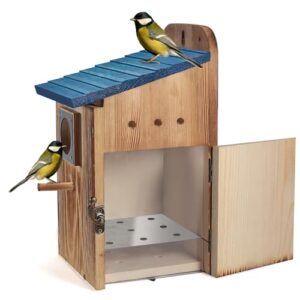
The Blue Bird House with Predator Guard is like a fortress for your feathered friends.
Built from sturdy premium pine and topped with a sleek copper guard, it protects nests from sneaky invaders like raccoons or snakes.
Its burnt wood finish is both charming and withstands weather.
Fully assembled, it’s ready to hang hassle-free, making your setup a breeze.
With its thoughtful design, including easy-clean access and a clear viewing panel, this house combines style, safety, and practicality for happy bluebirds.
Best For: Birdwatchers, nature enthusiasts, and gardeners looking to provide a safe, stylish, and functional home for bluebirds.
- Durable 3/4" treated pine with weather-resistant design.
- Includes copper predator guard for added nest security.
- Fully assembled and easy to hang for convenience.
- Limited to small bird species like bluebirds.
- Fixed design offers no customization options.
- May require additional mounting poles for certain setups.
6. Waterproof Wooden Bluebird House Outdoor
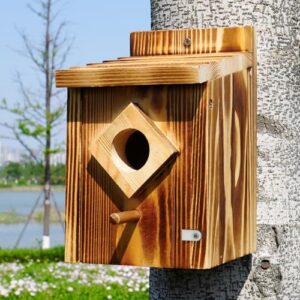
If you’re looking for a dependable birdhouse, the Waterproof Wooden Bluebird House Outdoor is a winner.
The Waterproof Wooden Bluebird House Outdoor is a reliable haven, combining weatherproof durability with cozy charm for happy nesting bluebirds.
Made from durable, natural wood with a waterproof finish, it stands up to harsh weather while offering a cozy home for bluebirds.
The 1.5-inch entrance hole welcomes nesting birds while deterring larger competitors.
Its front-opening design makes cleaning a breeze, and drainage holes keep rainwater from pooling.
Whether in your backyard or garden, this sturdy house promises safety and comfort for your feathered visitors—bluebird-approved!
Best For: Bird enthusiasts or nature lovers looking for an easy-to-install, weather-resistant birdhouse perfect for attracting bluebirds, wrens, and chickadees.
- Durable natural wood with a waterproof finish for outdoor durability.
- Easy maintenance with a front-opening design and drainage holes.
- Attracts desirable bird species with a 1.5-inch entrance hole.
- Protector square may not effectively deter sparrows.
- Requires occasional reapplication of waterproof treatment.
- Limited to smaller bird species due to entrance size.
7. Dreyoo Cedar Bluebird House Two Pack

The Dreyoo Cedar Bluebird House Two Pack is like a VIP suite for nesting pairs.
Crafted from durable cedar with carbonized surfaces, these houses resist harsh weather while looking stylish in your yard.
The 1.5-inch entrance hole features a metal guard to keep predators at bay, and fledgling grooves inside help young birds safely exit.
With easy-clean access, proper ventilation, and included mounting hardware, it’s simple to install and maintain.
Gift-worthy and bird-approved, these houses are perfect for welcoming bluebird families!
Best For: Bird lovers and backyard enthusiasts who want a durable and stylish bluebird house that’s easy to maintain.
- Durable cedar construction with weather-resistant carbonized surface.
- 1.5-inch entrance hole with predator guard for added safety.
- Easy access for cleaning and proper ventilation for bird comfort.
- Mixed opinions on the metal mesh shelf; may need removal.
- Requires additional drilling for some mounting situations.
- Higher price point compared to other birdhouses.
8. Wooden Bird House with Pole
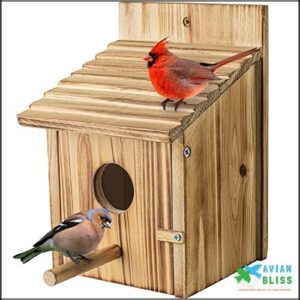
If you’ve got a soft spot for bluebirds, the Wooden Bird House with Pole is a simple yet sturdy choice.
Its natural wooden build offers a cozy, weatherproof nesting spot, while the pole mount keeps predators at bay.
The 1.57-inch entrance hole perfectly suits bluebirds, and the easy-clean side door makes maintenance hassle-free.
Hang it in an open, grassy area, and watch bluebirds claim it as their cozy home, it’s functional, charming, and ideal for attracting feathered residents quickly!
Best For: Nature lovers and bird enthusiasts looking for a durable, easy-to-maintain birdhouse to attract bluebirds and other small birds.
- Durable, weatherproof wooden construction.
- Easy to clean with a hinged side door.
- Pole-mounted design helps deter predators.
- Requires proper placement to avoid direct sunlight or winds.
- Smaller entrance size limits bird species.
- Light wood color may require treatment for extended use in harsh weather.
9. Cedar Bluebird House Viewing Window
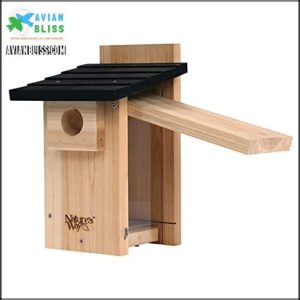
This cedar bluebird house with a viewing window offers a perfect blend of function and fun.
Its spacious interior, predator guard, and proper ventilation keep your feathered friends safe and cozy.
The crack-resistant window lets you peek at their progress without disturbing them—think of it as birdwatching with VIP access!
Cleaning is a breeze thanks to its removable doors, and the raised mesh floor reduces pesky parasites.
Mount it facing east in an open yard, and enjoy the cheerful sight of nesting pairs.
Ensuring the correct entrance hole size matters for bluebird comfort and safety is essential.
Best For: Bird enthusiasts who want a durable, easy-to-maintain birdhouse that attracts bluebirds and allows for monitoring without disturbance.
- Durable cedar construction with weather-resistant hardware.
- Predator guard and raised mesh floor ensure bird safety and health.
- Viewing window allows for observation without disturbing the birds.
- Some units may arrive with defects or inadequate packaging.
- Limited directional installation may hinder placement flexibility.
- Entrance hole size may require consideration for specific bird species.
Bluebird House Specifications
If you want bluebirds to feel right at home, their house needs to meet specific requirements—no compromises here!
From the perfect entrance hole size to features like ventilation and drainage, every detail helps keep these feathered tenants safe, dry, and happy.
Entrance Hole Sizes for Different Bluebird Species
The entrance hole size of your bluebird house is a game-changer for nesting pairs.
Eastern Bluebirds need 1.5-inch round openings, while Western and Mountain Bluebirds prefer 1.56 inches.
This species-specific need keeps sparrows out and guarantees fledgling safety.
A perfect birdhouse entrance diameter impacts who moves in, so measure carefully—it’s like locking the right door for the right tenant, which is a critical step in attracting the desired bluebird species.
Ventilation and Drainage in Bluebird Houses
Good ventilation and drainage are non-negotiable in bluebird house design. They keep nests dry and comfy, reducing moisture buildup.
Follow these tips:
- Drill four floor holes for moisture control.
- Add sidewall gaps near the roof for airflow design.
- Choose a roof overhang to shield from rain.
Your bluebird neighbors will thank you!
Materials and Features for Bluebird Houses
Picking the right materials is like setting the stage for a bluebird’s perfect home. Use untreated wood like cedar for durability. Guarantee sloped roofs for weather, proper drainage, and ventilation needs.
Add predator guards for safety. A 4×4 floor guarantees cozy dimensions. Many builders prefer cedar for construction due to its resistance to decay.
Here’s a quick checklist below:
| Feature | Purpose |
|---|---|
| Untreated Wood | Durable, safe material |
| Sloped Roof | Keeps rainwater out |
| Drainage Holes | Prevents soggy nests |
| Ventilation Needs | Reduces heat buildup |
| Predator Guards | Shields from predators |
Keep it simple, but thoughtful!
Creating Bluebird Habitat
You can create a perfect bluebird habitat by providing food, water, and open spaces for foraging.
Think of it as building a bird-friendly buffet, complete with fruiting shrubs, freshly mowed grass, and a splash-worthy water source to keep them coming back.
Planting Fruit Trees and Shrubs for Food
Plant fruiting trees and shrubs to guarantee bluebirds have year-round food.
Berry-producing plants like elderberries and blackberries are favorites. Enhance their habitat with bird-friendly gardening.
These additions provide bluebird food but also boost shelter. Pair this with water sources for a thriving bluebird habitat.
Think of it as offering a buffet for your feathered friends!
Maintaining Lawns for Foraging Conditions
A well-maintained lawn creates the perfect bluebird habitat.
Mow frequently to keep the grass short, making it easier for bluebirds to spot ground-dwelling insects.
Avoid heavy pesticides to protect their insect food.
Include natural perch placements like low branches or fences near short grass areas.
Whether on farms or suburban yards, healthy lawns enhance bluebirds’ foraging success while inviting them to stay, creating an ideal environment for their overall well-being.
Providing Water Sources for Bluebirds
Ever wonder why bluebirds love a splash? Providing fresh water supports their drinking and bathing habits.
Here’s how you can help:
- Offer bird baths with good water quality—clean them often to prevent disease.
- Add a misting system; nestlings find them invigorating.
- Place water away from predators for safety.
- Heated baths guarantee winter water access.
Bluebirds also need shallow water sources, as bird baths suffice. Bluebirds will thank you!
Bluebird House Maintenance
Keeping your bluebird house in top shape isn’t just a chore—it’s a key step to keep these feathered families safe and thriving.
By regularly cleaning out old nests and ensuring the house stays dry and pest-free, you’ll create a welcoming space where bluebirds can settle down and raise their chicks.
Regular Checks and Monitoring for Bluebirds
Keeping a bluebird house safe means regular checks.
Monitor your bluebird nesting box for nesting success and blowfly control. Swap infested nests with clean, dry ones—think of it as offering a fresh start.
Sparrow spookers help keep invaders out. Follow Cornell NestWatch guidelines to track activity.
Remember, maintenance guarantees fledgling assistance and creates a welcoming space for bluebirds.
Cleaning and Maintaining The Bluebird House
Cleaning your bluebird house isn’t glamorous, but it’s essential! Start with a nestbox inspection after each brood fledges.
Wear a mask, remove old nest material, and scrub with a 10% bleach solution. Rinse well, let dry, and don’t forget:
- Tighten screws for stability.
- Check for predator deterrents.
- Reapply wasp prevention methods.
- Clean drainage holes.
- Store unused boxes indoors to prevent damage and ensure they remain in good condition for the next breeding season, which is a crucial part of maintenance.
Tips for Attracting Bluebirds to Nest Boxes
Attracting bluebirds starts with smart birdhouse tips: place nesting boxes in open spaces, at the right height, and face them east to avoid wind.
Habitat planting like berry shrubs adds charm, while Mealworm Feeders and a Water Source seal the deal.
Entrance hole sizes are also important for attracting the right species.
Use Sparrow Deterrents to protect nesting boxes—because no one likes uninvited guests ruining the party!
Frequently Asked Questions (FAQs)
What kind of bird house do bluebirds like?
Bluebirds love houses placed in open spaces, made of durable wood with proper ventilation, drainage holes, and predator guards.
Make certain a 4"x4" floor, 12" height, and overhanging roofs.
Add easy-clean access—bluebirds appreciate thoughtful landlords!
Which way do you face a bluebird house?
You’ll want to face the bluebird house east, toward open spaces.
This keeps harsh winds out and gives bluebirds a warm, sunny start to their day—like their own cozy breakfast nook!
How big should a birdhouse be for a bluebird?
Think of a bluebird house as a cozy studio apartment.
It should be 4×4 inches inside, 12 inches tall, with proper ventilation, drainage holes, and predator guards.
Bluebirds love a well-designed, airy space!
How do you attract bluebirds to a bluebird house?
Place your house in open, grassy areas with nearby perches.
You’ll need proper ventilation, drainage, and predator guards.
Offer mealworms in feeders and provide fresh water.
Regular monitoring keeps competitors away.
Can Bluebirds live in a birdhouse?
Yes, your birdhouse isn’t just shelter—it’s a potential home where bluebirds thrive.
They’ll readily nest in properly designed houses with correct dimensions, ventilation, drainage, and mounting in open, grassy areas away from predators, which makes the birdhouse a potential home.
How big should a Bluebird house be?
Your bluebird house should have a 4"x4" floor with 12" height for comfort.
Don’t skimp on space – these feathered families need room!
Include ventilation gaps and drainage holes for their cozy avian apartment, with complete concepts like these in mind to ensure their comfort.
Which Bluebird house is best?
While everyone dreams of architectural perfection for their feathered friends, the best bluebird house offers proper ventilation, drainage, a sloped roof, and easy-clean access.
Cedar houses with predator guards provide ideal protection for your chirping neighbors.
What makes a house for bluebirds?
Your ideal bluebird house needs a 4"x4" floor, 12" height, single-sloped roof, ventilation gaps, drainage holes, east-facing entrance, and easy-clean access. Mount it in open, grassy areas with predator guards.
What color bird houses attract bluebirds?
Like a beacon in your garden, natural, earth-toned houses in light blue, gray, or beige attract bluebirds.
You’ll have better luck with these colors than bright or dark ones that may deter these beautiful visitors.
How do bluebirds find birdhouses?
Your feathered friends spot birdhouses primarily through keen eyesight.
They’ll scope out potential homes during territorial flights, attracted by proper placement in open grassy areas with nearby perches for hunting insects.
Conclusion
With proper bird houses for bluebirds, you’ll triple your chances of attracting nesting pairs compared to random boxes.
Remember, success hinges on correct hole size, placement, and protection. Maintain your bluebird house seasonally, monitor for unwanted guests.
Whether you choose pre-made boxes or DIY projects, you’re not just providing shelter—you’re helping preserve these beloved songbirds for generations to come. Happy birding!
- https://www.quartoknows.com/books/9780760368626/Audubon-Birdhouse-Book-Revised-and-Updated.html
- https://birdsoftheworld.org/
- https://www.birdersgarden.com/bluebird_house_viewing_window_p/bcbb-ult.htm?srsltid=AfmBOopXssMnSOENeetkP2v2poiRQaJUe4BDuybtwg8WC00fqieqe3_n
- https://www.amazon.com/Natures-Way-Bird-Products-CWH4/dp/B00AQ3CP2M
- https://www.bestnest.com/ver2024/RTProduct.asp?SKU=NWB-CWH4&srsltid=AfmBOorVOPYLzjs6a6uB_Lyo6w4Mhea58Lo3tjiNTucbJ2B07ph_6x9l

